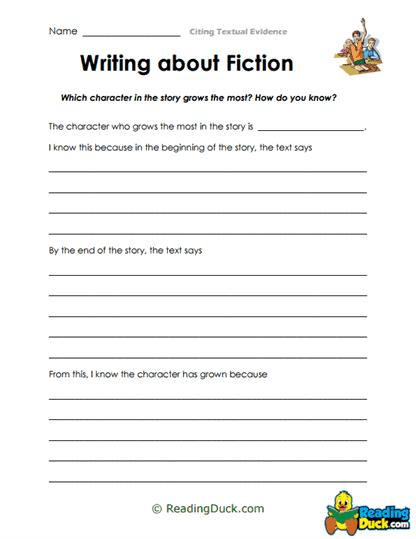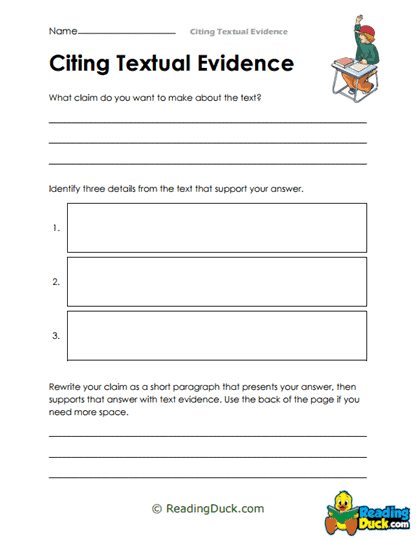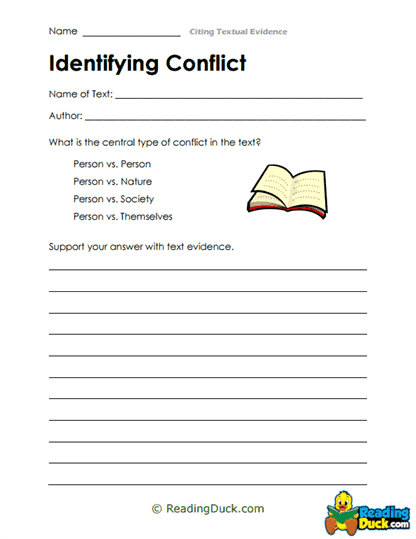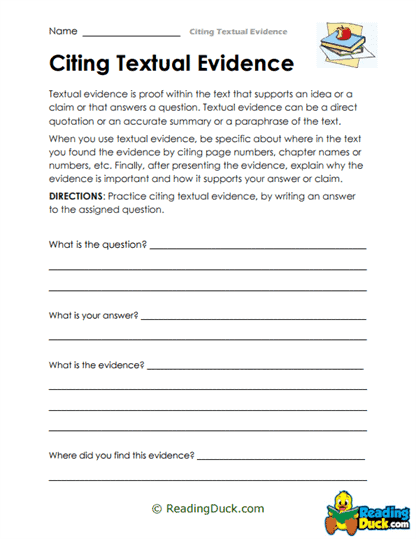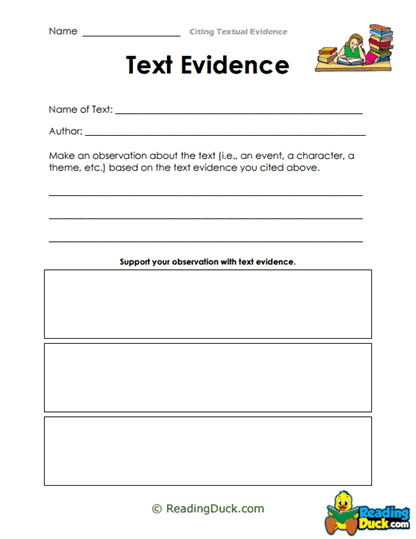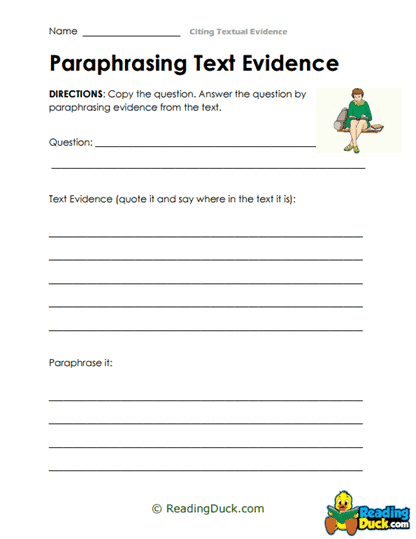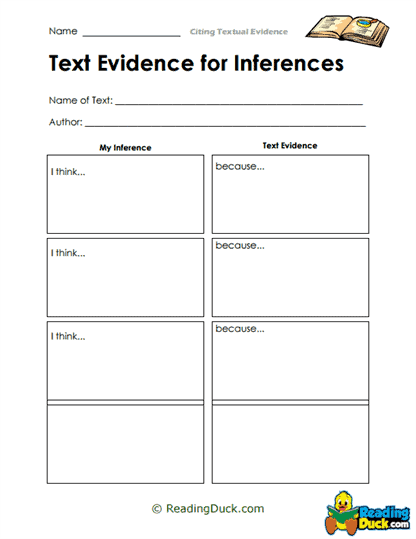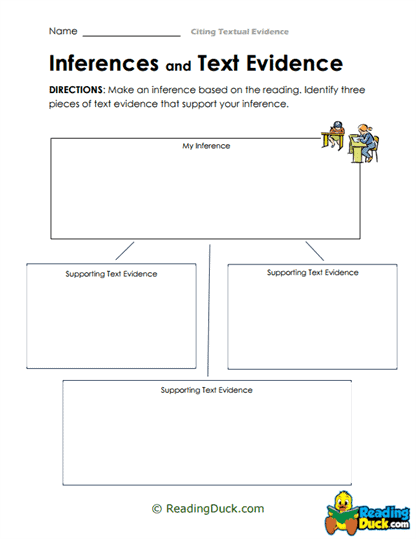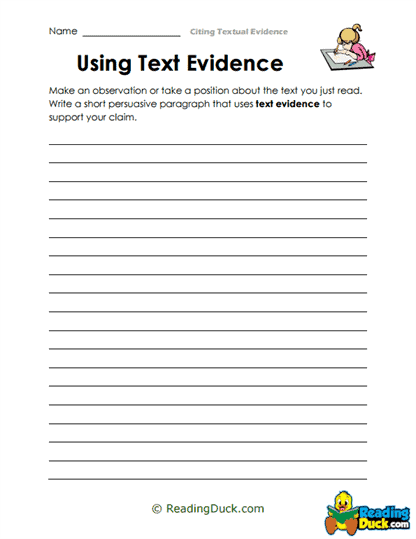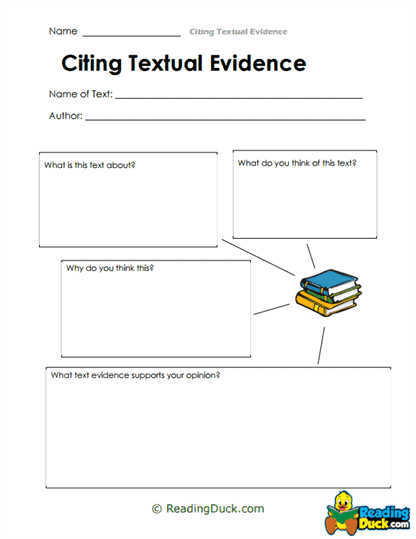Citing Textual Evidence Worksheets
About Our Citing Textual Evidence Worksheets
Our Citing Textual Evidence Worksheets collection is designed to help students master the skill of supporting their writing with clear, relevant evidence from texts. These worksheets provide a straightforward, accessible way to practice this essential academic skill.
Key Features:
- Available in PDF format for easy viewing, downloading, and printing.
- Each worksheet includes a downloadable answer key.
- Suitable for middle and high school students, these resources help students become thoughtful, evidence-based writers.
Students will build the confidence they need to integrate textual evidence into their writing, improving their ability to analyze texts and strengthen their arguments.
Understanding the Importance of Citing Textual Evidence
Citing textual evidence is an essential skill for students to master as it forms the backbone of strong, persuasive writing in both academic and real-world contexts. It requires students to locate and use specific evidence from a text to support their arguments or analysis. This process not only strengthens their writing but also promotes a deeper understanding of the material they are studying. Whether they are analyzing literature, crafting a persuasive essay, or responding to a prompt in a standardized test, the ability to cite relevant evidence is crucial to presenting a convincing argument.
Citing textual evidence goes beyond simply copying and pasting quotes into an essay. Students must learn to select the most appropriate evidence, decide how it supports their claim, and seamlessly integrate it into their writing. Additionally, they need to follow proper citation rules, whether using direct quotations or paraphrasing the text. Mastery of this skill ensures that students can defend their ideas with confidence, clarity, and credibility.
Why Citing Textual Evidence is Important:
- Strengthens Arguments: By backing up their claims with concrete evidence, students' arguments become more credible and convincing. Rather than relying on opinions or vague statements, they can support their ideas with proof directly from the text.
- Encourages Close Reading: To cite evidence effectively, students must engage in close reading. This means going beyond surface-level understanding to identify key points, themes, or ideas that relate to their arguments. Close reading helps students develop a more nuanced understanding of the material.
- Improves Analytical Skills: Citing evidence is not just about finding a quote and inserting it into an essay. Students must also analyze how the evidence supports their argument, explain its relevance, and connect it to the overall claim. This process sharpens their analytical thinking skills and deepens their engagement with the text.
- Prepares for Academic and Professional Writing: Whether students are writing a research paper, literary analysis, or argumentative essay, the ability to cite evidence is fundamental in academic settings. Moreover, citing sources properly is a critical skill in professional fields, such as law, journalism, and the sciences, where supporting claims with evidence is an integral part of the job.
- Builds Credibility: In any piece of writing, providing evidence shows that the writer has done their research and can support their claims with factual information. This builds the writer's credibility and helps convince readers that their arguments are valid.
For example, when analyzing a novel, a student might be asked to support a theme or character development using quotes or events from the text. If they claim that a character is courageous, they will need to cite specific moments where the character demonstrates bravery, rather than just stating their opinion. By linking their claims to the text, students provide a strong foundation for their argument.
In addition, citing textual evidence is important across various subject areas, not just in language arts. In history, students may need to support their analysis of historical events with primary sources or documents. In science, they may need to back up their hypotheses with data or research findings. The ability to effectively integrate evidence into their writing ensures students are prepared for any type of academic challenge.
Examples of Where Citing Textual Evidence is Crucial:
- Literary Analysis: Students support their interpretation of themes, character motivations, or plot points with quotes and references from the text.
- Persuasive Writing: Evidence is necessary to persuade readers of the validity of an argument, whether it’s in a debate essay, a research paper, or even a speech.
- Standardized Tests: Many reading comprehension and writing sections on tests such as the SAT, ACT, or AP exams require students to cite evidence to answer questions or construct arguments.
By using our worksheets, students will learn to confidently integrate textual evidence into their writing, improving their ability to support their claims in any academic or real-world writing task. As students practice this skill, they will also become more critical readers, better able to engage with and analyze complex texts.
Building Core Writing and Critical Thinking Skills
These worksheets are designed to improve both writing and critical thinking skills by helping students:
- Identify relevant evidence from various types of texts.
- Integrate evidence smoothly into their own writing.
- Evaluate whether the evidence adequately supports their argument.
- Understand different citation formats (MLA, APA, etc.).
By focusing on these core skills, students will enhance their ability to:
- Write well-structured essays.
- Analyze texts more deeply.
- Develop a clear, evidence-based point of view.
This skillset is valuable across subjects, making the worksheets relevant not only for English language arts but also for history, science, and social studies.
Encouraging Creativity and Critical Thinking
Our worksheets don’t just teach students how to cite evidence—they also encourage them to think critically and creatively about how to use it. Students learn to:
- Analyze texts from different perspectives.
- Evaluate conflicting interpretations of the same evidence.
- Synthesize information to support more complex ideas.
For instance, students might be tasked with identifying evidence that supports two opposing viewpoints. This helps develop creative thinking and deepens their engagement with the material. These skills are not limited to academic writing; they also foster independent thought and creativity in analysis.
Adaptability and Differentiated Instruction
These worksheets are highly adaptable, making them suitable for students of various grade levels and skill levels. Teachers can easily modify exercises to accommodate different learning styles and paces.
Differentiation Options:
- For beginning students: Focus on simple citations, such as directly quoting from a text.
- For advanced learners: Challenge students to summarize larger text sections or synthesize evidence from multiple sources.
- Suitable for independent study, allowing students to practice at their own pace.
This flexibility makes the worksheets ideal for mixed-ability classrooms, and teachers can easily adjust the complexity of the exercises to ensure all students are engaged and challenged.
Integration with Broader Units and Projects
These worksheets can be seamlessly integrated into larger units or long-term projects, making them a versatile tool for both teachers and students. They provide a solid foundation for more complex assignments.
Integration Ideas:
- Essay Writing: Use worksheets to prepare students for citing evidence in full-length essays.
- Literary Analysis: Incorporate into units where students analyze themes, characters, and settings using textual evidence.
- Group Projects: Prepare for debates, presentations, or discussions where evidence-based arguments are needed.
- Project-Based Learning: Use as the starting point for larger, creative assignments such as performance tasks, research projects, or debates.
These worksheets offer a structured way for students to build essential skills while still allowing for creative and collaborative learning experiences.
Complementary Activities for Engagement
To enhance the effectiveness of these worksheets, teachers can pair them with engaging activities that reinforce the skills learned. These activities can make learning more interactive and fun while still focusing on critical writing skills.
Examples of Complementary Activities:
- Group Discussions: After completing a worksheet, have students present their findings and compare how different evidence supports various arguments.
- Research Projects: Assign students a topic to research, then have them cite evidence to support their claims in essays or presentations.
- Fact vs. Fiction Activity: Students research a historical event, then write two accounts—one factual and one fictional—to highlight the importance of using evidence in writing.
- Creative Writing: Ask students to write their own stories, integrating textual evidence in a similar way to the texts they’ve analyzed.
These activities ensure students stay engaged while practicing their writing and analytical skills.
Ideal Grade Levels and Adaptability
While these worksheets are most appropriate for middle and high school students, they can be adapted to fit different grade levels and abilities.
Suggested Grade Levels:
- Middle School (Grades 6-8): Introductory worksheets focusing on identifying simple evidence and quotes.
- High School (Grades 9-12): More advanced worksheets that require students to integrate multiple pieces of evidence and use proper citation formats.
The adaptability of these worksheets means they can be used in a variety of classroom environments, from advanced English classes to mixed-ability groups.
Promoting Student Engagement and Independent Learning
Our Citing Textual Evidence Worksheets encourage active learning by presenting thought-provoking exercises that keep students motivated and involved in the writing process. The interactive nature of these activities ensures that students remain engaged while practicing their critical writing skills.
Benefits for Students:
- Independent study: Students can use the worksheets on their own to practice and improve their skills.
- Motivating exercises: The tasks are designed to be challenging yet manageable, helping students feel accomplished and motivated to improve.
By using these worksheets, students will develop not only their writing skills but also their ability to think critically, analyze texts, and build strong, evidence-based arguments.
Conclusion
Our Citing Textual Evidence Worksheets are a valuable resource for educators, parents, and students alike. Whether integrated into larger projects or used as standalone exercises, these worksheets provide the tools needed for students to become skilled, confident writers. With adaptable, engaging activities, students will develop essential writing and critical thinking skills while staying motivated and involved throughout the learning process.
These worksheets are an ideal choice for enhancing academic success and ensuring students are prepared to meet the challenges of evidence-based writing across all subjects.
